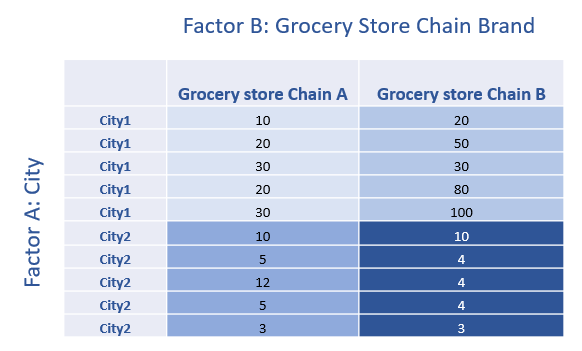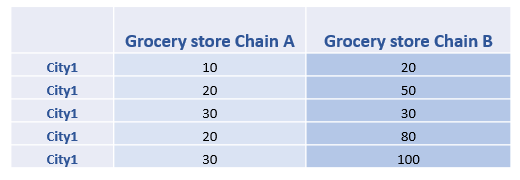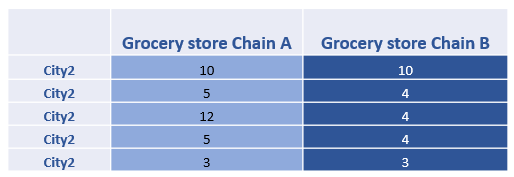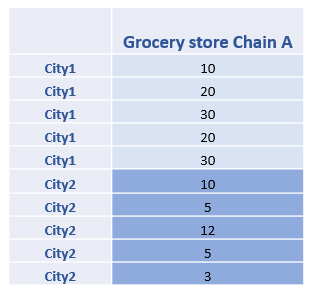Two-Way ANOVA: Formulas and Calculation by Hand
This tutorial will first show the formulas for Two-way ANOVA and then use an example to show how you can calculate two-way ANOVA by hand.
The following depicts the conceptual framework of the variance breaking down for two-way ANOVA. Typically, Two-way is used for experiment data analyses.
- SST is total variability.
- SSM is variance explained by the experiment.
- SSR is the unexplained variability.
- SSA is variance explained by factor A.
- SSB is variance explained by factor B.
- SSAB is variance explained by the interaction of A and B.

Data example for two-way ANOVA
This is the data example for two-way ANOVA used in this tutorial. In particular, suppose you design an experiment to see how different cities and different grocery chain brands can impact sales. The following is the data. Thus, Factor A is City, and Factor B is Chain Brand.

Formula of total sums of squares (SST)
Suppose that we have factors A and B. Thus, the grand sum of squares SST can be written as follows.
SST=SSM+SSR = SSA+ SSB+SSAB +SSR
For SST, you can use the following formula.
\( SS_T=\sum \sum (x_{ij}-\bar{x})^2 \)
For the data example mentioned earlier, the grand mean is 22.5, and thus we can calculate the SST =13235.
SST=(10-22.5)2+(20-22.5)2+(20-22.5)2+…+(3-22.5)2= 13235
Formula of sum of squares (SSM)
The next step is to calculate sum of squares (SSM) for the whole model, namely the experiment model. The following is the formula for SSM. We assume all the number of observations is the same across cells.
\[SS_{M}=n_{cell} \sum \sum (\bar{x_{ij}} -\bar{x})^2\]
We can use the formula above to calculate SSM for the example mentioned earlier. Note that, we got 4 cells in the experiment, and each cell has 5 members.
SSM=5(22-22.5)2+5(56-22.5)2+5(7-22.5)2+5(5-22.5)2=8345
The degree of freedom for SSM is the number of cells minus 1. We have 4 cells, and thus, the degree of freedom is 3.
Formula of main effect of factor A(City)
We can then calculate the main effect of SSA based on the following formula.
\[ SS_A= \sum n_i (\bar{x_i} -\bar{x})^2 \]
We can then calculate the sub-grand means for City 1, which is 39. Similarly, we can get the sub-grand means for City 2, which is 6.


Thus, we can calculate the main effect of SSA.
SSA= 10(39-22.5)2+10(6-22.5)2=5445
The degree of freedom for SSA is the number of groups used, k, minus 1. Here, we have 2 groups, namely City 1 and City 2. Thus, the degree of freedom for SSA is 2-1=1.
Formula of main effect of factor B (Chain Brand)
Similarly to factor A, we can calculate the SSB as follows. The following is the formula.
\[ SS_B= \sum n_j (\bar{x_j} -\bar{x})^2 \]
First, let’s show the data for Chain A and Chain B separately. We can get a sub-grand mean for Chain A is 14.5, and the sub-grand mean for Chain B is 30.5.


Then, similar to SSA, we can calculate SSB as follows.
SSA= 10(14.5-22.5)2+10(30.5-22.5)2=1280
The degree of freedom for SSB is also 2-1=1.
Two methods to calculate interaction effect SSAB
Method 1
We can calculate the interaction effect of SSAB using the following formula.
SSAB =SSM – SSA– SSB
Thus, we can get the SSAB as 1620.
SSAB =8345 – 5445- 1280 =1620
The degree of freedom for SSAB is calculated as follows. Thus, the degree of freedom for SSAB is 1.
dfAB=dfM-dfA-dfB=3-1-1=1
Method 2
There is another way to calculate SSAB. The following is the formula, assuming the equal size of all cells, i.e., m.
\[ SS_{AB} = n_{cell} \sum \sum (\bar{x_{ij}}-\bar{x_i}-\bar{x_j}+\bar{x})^2 \]

Thus, we can calculate as follows. We can see that this method reaches the same result as the first method.
SSAB= 5((22-14.5-39+22.5)2+(7-14.5-6+22.5)2+(56-30.5-6+22.5)2+(5-30.5-6+22.5)2)=1620
Calculation of residual sum of squares SSR
We can also calculate SSR using the following formula.
SSR =SS2cell 1 + SS2cell 2+…+SS2cell n
The followings are Cell 1 and Cell 2 data. Cell 1’s mean is 22, whereas Cell 2’s mean is 7.


Thus, we can calculate the Sum of Squares for these two cells as follows.
SS2cell1 =(10-22)2+2(20-22)2+2(30-22)2=280
SS2cell2 =(10-7)2+2(5-7)2+(12-7)2+(3-7)2=58
Similarly, we can also calculate cell 3 and cell 4. The data is as follows.


SS2cell3=(20-56)2+(50-56)2+(30-56)2+(80-56)2+(100-56)2=4520
SS2cell4 =(10-5)2+3(4-5)2+(3-5)2=32
We can then calculate the SSR, which is 4890.
SSR =280+58+4520+32= 4890
We can check to see if our calculation so far is correct (see the updated variance breaking down figure shown below). As we can see, \( SS_T =13235 \) is based on the first calculation in this tutorial. At the same time, \( SS_M+SS_R\) also reach \(13235 \). Thus, we can see that our calculations are correct.
SST =SSM+SSR= 4890+8345 = 13235

The degree of freedom for SSR is the number of observations minus the number of cells. Thus, it is 20-4=16.
Mean squares for two-way ANOVA
We can then calculate the mean squares for two-way ANOVA. Mean squares are the ratio of the sum of squares and the degree of freedom. The followings are the formulas and examples for mean squares of main effects, interaction effect, and residual in two-way ANOVA.
\[ MS_A=\frac{SS_A}{df_A} = \frac{5445}{1}=5445 \]
\[ MS_B=\frac{SS_B}{df_B} = \frac{1280}{1}=1280 \]
\[ MS_{AB}=\frac{SS_{AB}}{df_{AB}} = \frac{1620 }{1}=1620 \]
\[ MS_R=\frac{SS_R}{df_R} = \frac{4890}{16}=305.625 \]
F-ratio for two-way ANOVA
We can then calculate the F-ratio for two-way ANOVA as follows. That is, F-ratio is the ratio between the mean squares of that effect and the mean squares of residuals. We can see that the F-ratio for factor A is 17.816. The F-ratio for factor B is 4.188. The F-ratio for the interaction effect is 5.301.
\[ F_A=\frac{MS_A}{MS_R} = \frac{5445}{305.625}=17.816 \]
\[ F_B=\frac{MS_B}{MS_R} = \frac{1280}{305.625}=4.188 \]
\[ F_{AB}=\frac{MS_{AB}}{MS_R} = \frac{1620}{305.625}=5.301 \]
You can compare the results of this manual calculation of two-way ANOVA with the one using Excel shown in another tutorial (the link here). We can see the F-ratios are exactly the same. That means we calculate correctly here.
Discussion